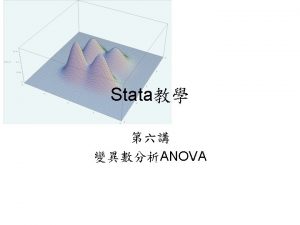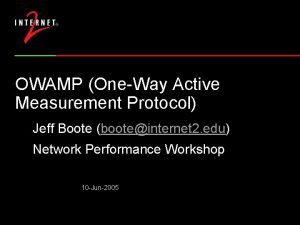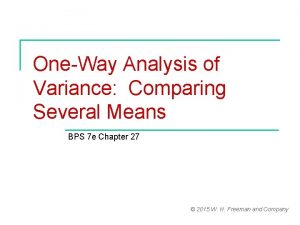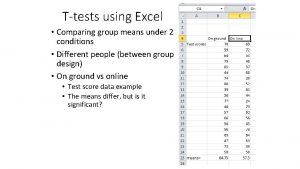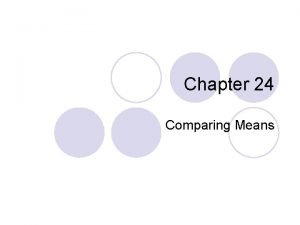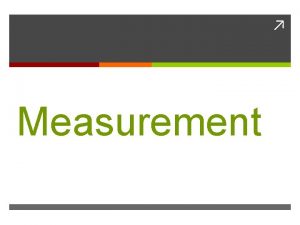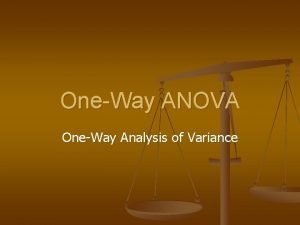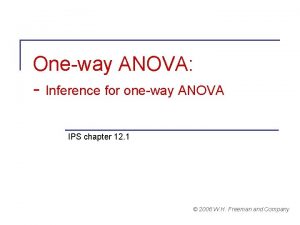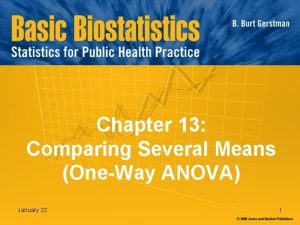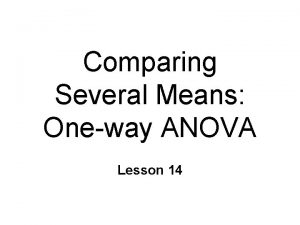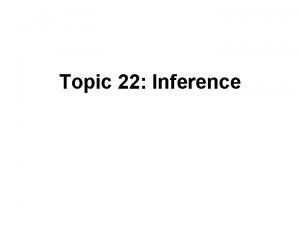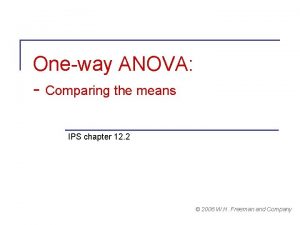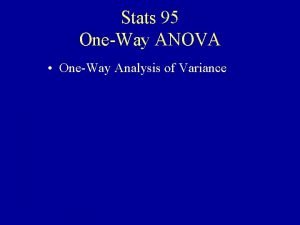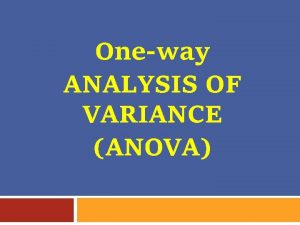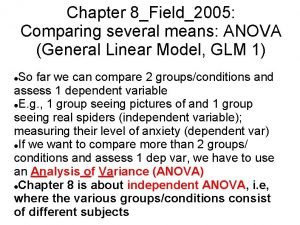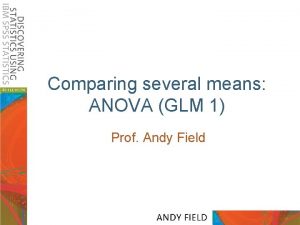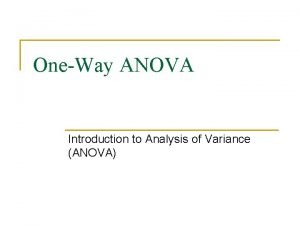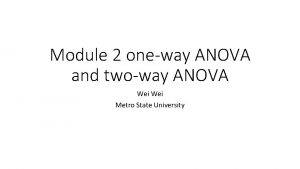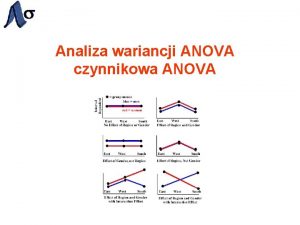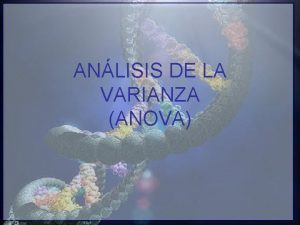Oneway ANOVA Comparing several means 1 Inference for



















- Slides: 19

One-way ANOVA Comparing several means 1

Inference for the mean � We know how to perform inference for 1 or two samples of quantitative data where μ is our parameter of interest. ◦ Z vs. T inference � Now we will compare one variable over more than two samples using a one-way Analysis of Variance (ANOVA) Test

Comparing several means � The first step is to see if there is an overall difference between the groups: H 0: All means µi are equal ⇔ µ 1 =µ 2 = … = µk Ha: Not all means µi are equal � This will require a new distribution, the F distribution � If we find a difference, we will follow up to see which group (or groups) are different 3

Means of groups visually If we have sampled from the same (or similar enough) population the variance of the sample means should be close to the average sample variance Equal Population means If we have sampled from different populations then the variance of the sample means > the average sample variance Unequal Population means 4

ANOVA Asumptions Similar to Regression assumptions 1. Each sample must be independent SRSs. 2. Each population represented by the k samples must be Normally distributed. However, the test is robust to deviations from Normality for large-enough samples 3. The ANOVA F-test requires that all k populations have the same standard deviation σ. � � � There are inference tests for this, but they tend to be sensitive to deviations from the Normality assumption or require equal sample sizes. Equal sample sizes make the ANOVA more robust to deviations from the equal σ rule. A simple and conservative approach: The ANOVA F test is appropriate when the largest sample standard deviation is no more than about twice as large as the smallest sample standard deviation. 5

Analysis of Variance (ANOVA) tables � The basic format of a one way ANOVA table is as follows: Source D. o. F SS MS F P-Val Groups DFg SSG MSG Test Statistic ? Error DFE SSE MSE - - Total DFT SST - - - � Ultimately our goal is to find our F test Statistic and P-val to make our decision 6

Analysis of Variance (ANOVA) tables � � From there we begin filling out our table. The easiest place to start is D. o. F: Source D. o. F SS MS F P-Val Groups DFg SSG MSG Test Statistic ? Error DFE SSE MSE - - Total DFT SST - - - D. o. F. for Groups: DFg = # of Groups-1 = k-1 � Next we need the total D. o. F. � From there: DFT = n-1 DFE =DFT-DFg= (n-1)-(k-1)= n-k 7

Analysis of Variance (ANOVA) tables � Source D. o. F SS MS F P-Val Groups DFg SSG MSG Test Statistic ? Error DFE SSE MSE - - Total DFT SST - - - 8

Analysis of Variance (ANOVA) tables � Once we have our SS column calculated we then scale by the D. o. F. to find the MS Source D. o. F SS MS F P-Val Groups DFg SSG MSG Test Statistic ? Error DFE SSE MSE - - Total DFT SST - - - � MSG = SSG/DFg � MSE = SSE/DFE 9

Analysis of Variance (ANOVA) tables � Source D. o. F SS MS F P-Val Groups DFg SSG MSG Test Statistic ? Error DFE SSE MSE - - Total DFT SST - - - 10

The F Distribution � 11

ANOVA Table calculation Example � Suppose we were comparing k=6 groups and there were n=10 observations � Given: ANOVA Table Source Groups Error total � Fill D. o. F SS 0. 17820 0. 18665 MS - F p-value - - out the rest of the ANOVA table: 12

F Table Example � Full table should be: � From the Table: ◦ Between 0. 01 and 0. 001 � In Excel: 13

ANOVA Example 1 � Male lab rats were randomly assigned to 3 groups differing in access to food for 40 days. The rats were weighed (in grams) at the end. ◦ Group 1: access to chow only. ◦ Group 2: chow plus access to cafeteria food restricted to 1 hour every day. ◦ Group 3: chow plus extended access to cafeteria food (all day long every day). � Does the type of food access influence the body weight of male lab rats significantly? Chow Restricted Extended 516 546 564 547 599 611 546 612 625 564 627 644 577 629 660 570 638 679 582 645 687 594 635 688 597 660 706 599 676 714 606 695 738 606 687 733 624 693 744 623 713 780 641 726 794 655 736 667 690 703 14

ANOVA Example 1 � Hypotheses: H 0: µchow = µrestricted = µextended Ha: H 0 is not true (at least one mean µ is different) � First we must examine the data to check our assumptions: ◦ We can assume good sampling techniques ◦ Look at Boxplots for deviations from normality, outliers, equal variances ◦ Check summary Statistics 15

Minitab ANOVA Output � Stat -> ANOVA -> One-Way ◦ Default options are fine for our purposes � This means we Reject the Null. � In our context, this means there are significantly different responses for different treatments. � To see which ones, we must do a follow-up examination 16

ANOVA Follow-up � It is clear that the Chow group is significantly different from extended, and most likely from Restricted. � We can run follow up (pooled) t tests to find out for sure: 17

ANOVA Example 2 � The results of a study looking at the effect of treatments of brain tumors can be found in Canvas. We have 4 Groups: 1. 2. 3. 4. Irradiation Cannabinoids Irradiation & Cannabinoids Untreated � Our hypotheses would be: H 0: Means are the Same or: µI = µC = µI&R = µU Ha: H 0 is not true (at least one mean µ is different) 18

Examining the Data � We can assume good sampling techniques � Look at Boxplots for deviations from normality, outliers, equal variances � Check summary Statistics � We technically do not meet ANOVA assumptions here, however, there is clearly a difference 19
 Stata oneway
Stata oneway Owamp
Owamp One-way hash function
One-way hash function One way anova vs two way anova
One way anova vs two way anova Contoh soal analisis varians
Contoh soal analisis varians Perbedaan one way two way anova
Perbedaan one way two way anova Several means
Several means Comparing means in excel
Comparing means in excel Resting pulse rates for a random sample of 26
Resting pulse rates for a random sample of 26 Chapter 24 comparing means
Chapter 24 comparing means Morphe means in metamorphism
Morphe means in metamorphism Meta means change and morph means heat
Meta means change and morph means heat Biodiversity and conservation
Biodiversity and conservation Poly and gon
Poly and gon Bio means life logy means
Bio means life logy means Gibbs reflekterande cykel
Gibbs reflekterande cykel Varför kallas perioden 1918-1939 för mellankrigstiden
Varför kallas perioden 1918-1939 för mellankrigstiden Verksamhetsanalys exempel
Verksamhetsanalys exempel Stål för stötfångarsystem
Stål för stötfångarsystem Vishnuismen
Vishnuismen
